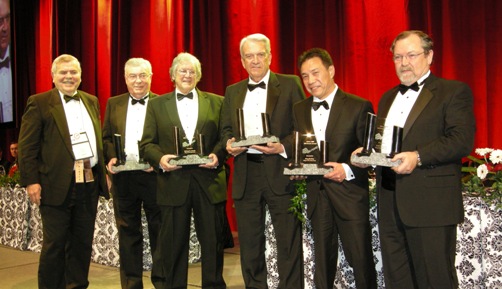
http://www.pendaproductions.com/ This video was produced by PENDA Productions, a full service production company specializing in Corporate Communications with a focus on Corporate Responsibility.
The PDAC Bill Dennis Prospector of the Year Award honors the memory of past PDAC president Bill Dennis who was one of the association’s staunchest supporters during its formative years and a prominent and respected prospector. This award is presented to individuals or groups who have made a significant mineral discovery, offered noteworthy contributions to the PDAC, or have been involved in some important service or technological invention or innovation that helped improve the Canadian prospecting and exploration industry.
John D. Harvey, Donald Hoy, Richard Nemis, Neil D. Novak and Mac Watson are recognized for the significant base metals and chromite discoveries in northern Ontario’s Ring of Fire.
In 2002, Neil Novak, as vice-president of Spider Resources Inc., was seeking kimberlites in the James Bay lowlands in a joint venture with KWG Resources Inc.
Novak had found 1.1-billion-year-old, diamond-bearing kimberlites under 130 metres of sand and limestone. De Beers Canada Exploration, curious about Novak’s work, formed a JV with Spider-KWG to look at their geophysical and geochemical database.
Novak’s expertise led De Beers to launch a reverse-circulation drill program near McFauld’s Lake, northern Ontario.
In May 2002, De Beers’ drill cut massive sulphide mineralization. The hole returned eight metres grading 1.61% copper, including a 0.5-metre section running 7% copper and almost 5% zinc.
Later that year, Spider published a released after staking 64 square kilometers around its discovery. Learning the news, Richard Nemis, then president and CEO of Noront Resources Ltd., found a contractor familiar with McFauld’s Lake to stake claims based on an airborne survey flown in 1959 by the Geological Survey of Canada.
Nemis says two claims contiguous to his showed some “unusual geophysical signatures.’ The claims were held by Condor Diamonds.
Novak was working Condor’s claims as a consultant but there was an ongoing court battle over their ownership. When litigation ended, Nemis secured the claims after agreeing to drill an anomaly outlined by Novak.
In August 2007, the first angle hole into Condor’s claims, later dubbed Eagle One, returned 1.1% nickel, 0.9% copper and 2.1 grams palladium over 71.5 metres of magmatic rock. A second hole found more mineralization but two holes east and west of the discovery hole proved barren.
With costs exceeding $100,000 per hole, Nemis stopped drilling and flew in consultant John Harvey. He examined the evidence and recommended the anomaly be drilled vertically. Hole five went straight down and returned 117 metres averaging 4.1% nickel and 2.2% copper, plus platinum and palladium.
Within six weeks more than 100,000 hectares had been staked along the Archean-aged greenstone belt that forms a kind of ring east of McFauld’s Lake. The rush prompted Nemis to dub the camp the Ring of Fire.
Further drilling at Eagle One has outlined an indicated resource of 1.8 million tonnes averageing 2% nickel, 1.2% copper and five grams combined platinum, palladium and gold per tonne. Another resource estimate is expected later this year.
Mac Watson, then president and CEO of Freewest Resources Canada Inc., was part of the original staking rush with Nemis. Watson assembled his own land package based on an old Inco airborne survey.
More than a year before the Eagle discovery, the Spider-KWG joint venture had drilled the SKF property at McFauld’s lake, optioned from Freewest. One hole returned two tin intersections of a jet-black mineral. “I and this other geologist kind of scratched our heads,” recalls Novack. “We pulled out our field manuals and eventually convinced ourselves that it was chrome.” The property was eventually renamed Big Daddy.
In September 2008, Freewest conducted a ground gravity survey along an ultramafic sill, known as the Ring of Fire Intrusion. Feewest ranked the gravity anomilies, thought to be nickel-copper deposits.
Drilling on the first targeted intersection more than 100 metres of high-grade chromite mineralization in the hanging wall of the nickel-copper target. After Hole 2 hit minor chromite, Freewest’s former vice-president of exploration, Donald Hoy, decided to test another gravity anomaly along trend, 1.6 kilometres away. That hole intersected almost 100 metres grading 30% chromite.
Follow-up drilling defined the deposit over a 1.6-km strike length. Mineralization remains open in both directions along strike.
Noront and Probe Mines Ltd. Have outlined similar chromite deposits but Black Thor is the Ring’s largest. It contains an inferred mineral resource of 69.5 million tonnes grading 32% chromite.
Chromite is transformed into ferrochrome and then alloyed with steel to make it more corrosion resistant. Steel producer Cliffs Natural Resources Inc. purchased Freewest for $240 million in January 2010.
Mining veteran Pierre Lassonde told the National Post in 2008 that the Ring of Fire is “the most exciting discovery of the last 10 years” in Canada. Indeed!























